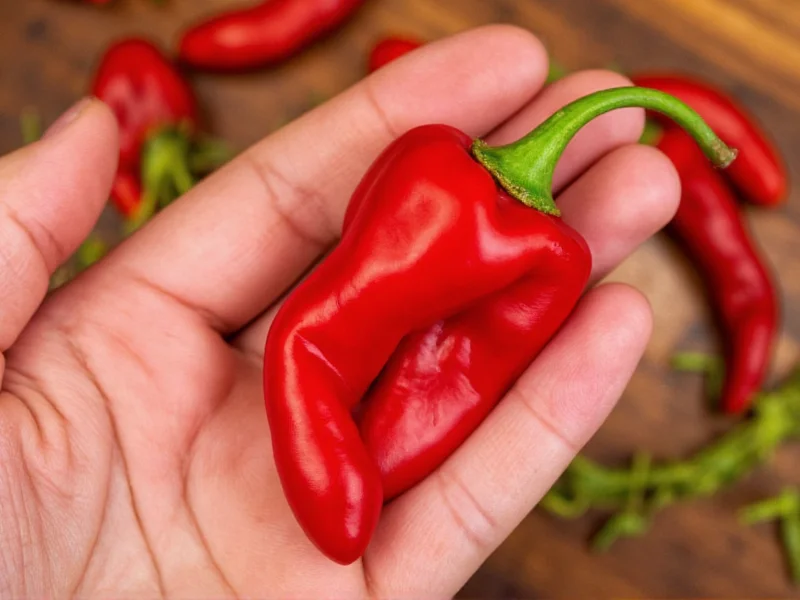The current world record holder for the hottest pepper in the world is the Carolina Reaper, officially verified by Guinness World Records with an average Scoville Heat Unit (SHU) rating of 1,641,183. Developed by South Carolina breeder Ed Currie, this pepper consistently measures between 1.4 to 2.2 million SHU on the Scoville scale, making it approximately 275 times hotter than a typical jalapeño.
Understanding pepper heat requires knowledge of the Scoville scale, the standard measurement for chili pepper pungency. Created by pharmacist Wilbur Scoville in 1912, this scale measures the concentration of capsaicinoids—the compounds responsible for a pepper's heat. Originally determined through human taste testing, modern laboratories now use high-performance liquid chromatography (HPLC) for precise, objective measurements.
The Carolina Reaper: King of Heat
Officially recognized by Guinness World Records in 2013, the Carolina Reaper (Capsicum chinense) features a distinctive red, bumpy appearance with a characteristic stinger-like tail. Its development resulted from crossbreeding a Pakistani Naga pepper with a Red Habanero from St. Vincent.
What makes the Carolina Reaper particularly challenging is its dual-phase heat experience. First comes an initial fruity, sweet flavor typical of many habanero varieties, followed by an intense, building burn that can last up to 30 minutes. This delayed reaction often catches inexperienced eaters off guard, contributing to its notorious reputation.
Scientific Verification and Testing
The Carolina Reaper's heat level isn't merely anecdotal—it's been rigorously tested by independent laboratories. Winthrop University in South Carolina conducted official testing that confirmed its record-breaking status. The testing process involves:
- Extracting capsaicinoids from pepper samples
- Using HPLC to separate and measure individual capsaicin compounds
- Converting these measurements to Scoville Heat Units using standardized calculations
- Testing multiple specimens to establish an accurate average
| Pepper Variety | Average SHU | Peak SHU | Guinness Recognition |
|---|---|---|---|
| Carolina Reaper | 1,641,183 | 2,200,000 | 2013-Present |
| Trinidad Moruga Scorpion | 1,200,000 | 2,009,231 | 2012-2013 |
| Naga Viper | 1,382,118 | 1,349,000 | 2011-2012 |
| Bhut Jolokia (Ghost Pepper) | 1,001,304 | 1,041,427 | 2007-2011 |
Safety Considerations for Handling Super-Hot Peppers
Working with peppers at this heat level requires serious precautions. The capsaicin concentration in Carolina Reapers can cause severe irritation to skin and eyes. Professional growers and handlers recommend:
- Wearing nitrile gloves (latex won't protect against capsaicin)
- Using safety goggles to protect eyes from accidental contact
- Working in well-ventilated areas to avoid inhaling capsaicin particles
- Avoiding touching your face during handling
- Having dairy products like milk or yogurt nearby to neutralize burns
Medical professionals warn that consuming extremely hot peppers can cause temporary but severe reactions including nausea, vomiting, and in rare cases, thunderclap headaches. Individuals with gastrointestinal conditions should exercise extreme caution.
Evolution of the World's Hottest Pepper
The quest for the hottest pepper has evolved dramatically over the past two decades. What was once a competition among naturally occurring varieties has transformed into a scientific breeding endeavor. The progression shows how selective breeding has dramatically increased capsaicin production:
- Pre-2000s: Habaneros and Scotch Bonnets (100,000-350,000 SHU) represented the upper limits of commercially available heat
- 2000-2007: The Bhut Jolokia (Ghost Pepper) emerged from India, shocking the world with over 1 million SHU
- 2007-2011: Bhut Jolokia's record stood until more intense hybrids began appearing
- 2011-2012: The Naga Viper briefly claimed the title through selective breeding
- 2012-2013: Trinidad Moruga Scorpion set new standards with verified tests over 2 million SHU
- 2013-Present: Carolina Reaper has maintained its official record status despite claims from newer varieties
Practical Applications of Super-Hot Peppers
Despite their extreme heat, peppers like the Carolina Reaper serve several practical purposes beyond culinary daredevilry:
- Medicinal uses: Capsaicin is used in topical pain relief creams and patches for conditions like arthritis and neuropathy
- Law enforcement: Oleoresin capsicum (OC) from hot peppers forms the basis of many pepper sprays
- Agricultural applications: Natural pest deterrent in organic farming practices
- Culinary innovation: Used in minute quantities to add complex heat to sauces, chocolates, and even beverages
- Scientific research: Studied for potential applications in pain management and cancer treatment
Chefs who work with Carolina Reapers emphasize precision and restraint—often using just a few drops of infused oil rather than the whole pepper. The flavor profile, when properly managed, includes notes of sweet fruitiness that complement the intense heat.
Pepper X and Other Contenders
While the Carolina Reaper maintains its official Guinness World Record status, several contenders have emerged. Notably, Ed Currie (the same breeder who created the Carolina Reaper) claims his newer Pepper X exceeds 3 million SHU. However, as of 2023, this hasn't received official verification through the rigorous testing process required by Guinness.
Other peppers frequently mentioned in hot pepper discussions include the Dragon's Breath and the Komodo Dragon pepper, though these lack the independent laboratory verification that supports the Carolina Reaper's status. The competitive nature of super-hot pepper breeding means this record could change with proper documentation and testing of new varieties.
Where to Experience the Carolina Reaper
For those interested in trying the world's hottest pepper, several options exist:
- Fresh peppers: Available at specialty farmers markets during harvest season (July-October)
- Dried peppers: Sold through online retailers and specialty spice shops year-round
- Hot sauces: Many commercial sauces feature Carolina Reaper as a primary ingredient
- Seeds: Available from reputable seed companies for home cultivation
- Pepper eating challenges: Some restaurants offer controlled challenges with medical supervision
Home growers should note that Carolina Reaper plants require specific growing conditions—warm temperatures, well-draining soil, and consistent watering. The plants typically reach 24-36 inches in height and produce peppers that transition from green to vibrant red as they mature.











 浙公网安备
33010002000092号
浙公网安备
33010002000092号 浙B2-20120091-4
浙B2-20120091-4